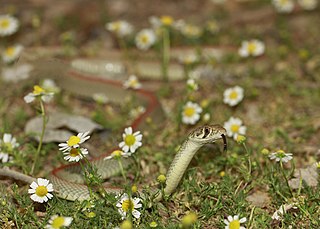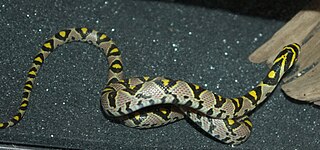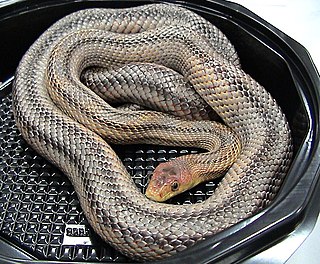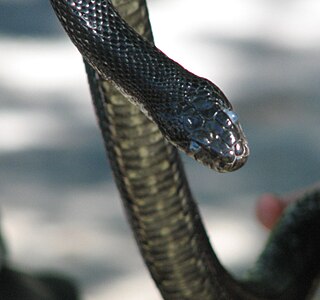
Rat snakes are members – along with kingsnakes, milk snakes, vine snakes and indigo snakes – of the subfamily Colubrinae of the family Colubridae. They are medium to large constrictors and are found throughout much of the Northern Hemisphere. They feed primarily on rodents. Many species make attractive and docile pets and one, the corn snake, is one of the most popular reptile pets in the world. Like all snakes, they can be defensive when approached too closely, handled, or restrained. However, rat snake bites are not dangerous to humans. Like nearly all colubrids, rat snakes pose no threat to humans. Rat snakes were long believed to be completely nonvenomous, but recent studies have shown that some Old World species do possess small amounts of venom, though the amount is negligible relative to humans.

The corn snake, sometimes called red rat snake, is a species of North American rat snake in the family Colubridae. The species subdues its small prey by constriction. It is found throughout the southeastern and central United States. Though superficially resembling the venomous copperhead and often killed as a result of this mistaken identity, the corn snake lacks functional venom and is harmless. The corn snake is beneficial to humans because it helps to control populations of wild rodent pests that damage crops and spread disease.

Colubridae is a family of snakes. With 249 genera, it is the largest snake family. The earliest species of the family date back to the Oligocene epoch. Colubrid snakes are found on every continent except Antarctica.

Pantherophis obsoletus, also known commonly as the western rat snake, black rat snake, pilot black snake, or simply black snake, is a nonvenomous species of snake in the family Colubridae. The species is native to central North America. There are no subspecies that are recognized as being valid. Its color variations include the Texas rat snake. Along with other snakes of the eastern United States, like the eastern indigo snake and the eastern racer, it is called “black snake”.

Platyceps rhodorachis the common cliff racer, Wadi racer, desert racer, braid snake, or Jan’s cliff racer, is a species of snake found in Central Asia.

The common trinket snake is a nonvenomous constrictor species of colubrid snake native to south Central Asia.

The mandarin rat snake is a species of nonvenomous colubrid snake endemic to Asia. It is closely related to Euprepiophis conspicillata, the Japanese forest rat snake. Mandarin rat snakes are one of the most popular rat snakes found in the pet trade.

Oreocryptophis porphyraceus is a rat snake species, commonly called the black-banded trinket snake, red bamboo snake, found in mid to upper-level elevations of forested hills in southeastern Asia, ranging from evergreen tropical to dry seasonal forests depending on the subspecies and locality. It is the only member of the genus Oreocryptophis, but it was formerly placed in Elaphe.

Gonyosoma prasinum is a species of colubrid snake found in Asia.

Coelognathus radiatus, commonly known as the radiated ratsnake, copperhead rat snake, or copper-headed trinket snake, is a nonvenomous species of colubrid snake.

Pantherophis vulpinus, commonly known as the foxsnake or the eastern fox snake, is a species of nonvenomous rat snake in the family Colubridae. The species is native to North America.

Pantherophis emoryi, commonly known as the Great Plains rat snake, is a species of nonvenomous rat snake in the family Colubridae. The species is native to the central part of the United States, from Missouri to Nebraska, to Colorado, south to Texas, and into northern Mexico.

Pantherophis bairdi is a species of harmless snake in the family Colubridae. The species is native to the southwestern United States and adjacent northeastern Mexico. No subspecies are recognized as being valid.

The Colubrinae are a subfamily of the family Colubridae of snakes. It includes numerous genera, and although taxonomic sources often disagree on the exact number, The Reptile Database lists 717 species in 92 genera as of September 2019. It is the second largest subfamily of colubrids, after Dipsadinae. Many of the most commonly known snakes are members of this subfamily, including rat snakes, king snakes, milk snakes, vine snakes, and indigo snakes.

The Italian Aesculapian snake is a species of snake in the Colubridae family.

The short-tailed snake is a small harmless colubrid snake. Fossorial and seldom seen, it is found only in sandy, upland parts of Florida where it is listed as Threatened and is protected by state law.

Pantherophis alleghaniensis, commonly called the eastern rat snake, is a species of nonvenomous snake in the family Colubridae. The species is endemic to North America.

The Transcaucasian ratsnake, also commonly known as the Gavand snake, is a species of nonvenomous ratsnake in the family Colubridae. The species is endemic to Western Asia and the Middle East.

Lampropeltini is a tribe of colubrid snake endemic to New World. These include the kingsnakes, milk snake, corn snake, gopher snakes, pine snakes, and bullsnakes. At least 51 species have been recognized and the group have been heavily studied for biogeography, morphology, ecology, and phylogenetics. The internal relationships among the genera has been disputed, but generally the most supported placement of the genera are as follows:
Euprepiophis perlaceus, also known as Sichuan rat snake or pearl-banded rat snake, is a species of snake in the family Colubridae snake. It is endemic to western Sichuan Province in China. This snake is designated as Endangered by the IUCN Red List. It is found in the Palearctic.



























